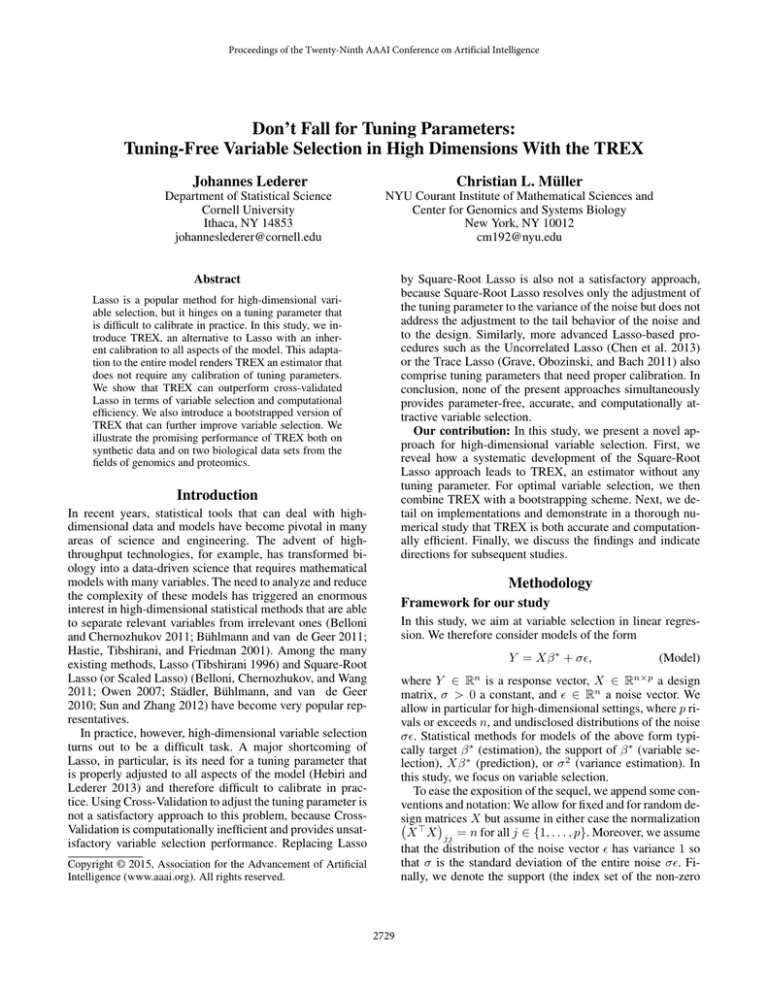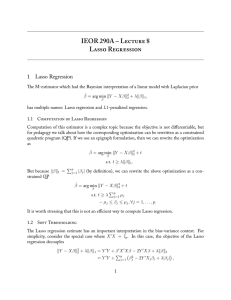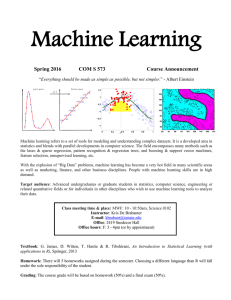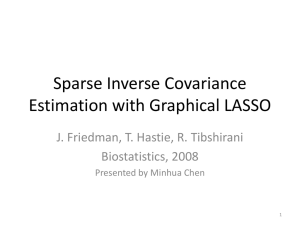
Proceedings of the Twenty-Ninth AAAI Conference on Artificial Intelligence
Don’t Fall for Tuning Parameters:
Tuning-Free Variable Selection in High Dimensions With the TREX
Johannes Lederer
Department of Statistical Science
Cornell University
Ithaca, NY 14853
johanneslederer@cornell.edu
Christian L. Müller
NYU Courant Institute of Mathematical Sciences and
Center for Genomics and Systems Biology
New York, NY 10012
cm192@nyu.edu
Abstract
by Square-Root Lasso is also not a satisfactory approach,
because Square-Root Lasso resolves only the adjustment of
the tuning parameter to the variance of the noise but does not
address the adjustment to the tail behavior of the noise and
to the design. Similarly, more advanced Lasso-based procedures such as the Uncorrelated Lasso (Chen et al. 2013)
or the Trace Lasso (Grave, Obozinski, and Bach 2011) also
comprise tuning parameters that need proper calibration. In
conclusion, none of the present approaches simultaneously
provides parameter-free, accurate, and computationally attractive variable selection.
Our contribution: In this study, we present a novel approach for high-dimensional variable selection. First, we
reveal how a systematic development of the Square-Root
Lasso approach leads to TREX, an estimator without any
tuning parameter. For optimal variable selection, we then
combine TREX with a bootstrapping scheme. Next, we detail on implementations and demonstrate in a thorough numerical study that TREX is both accurate and computationally efficient. Finally, we discuss the findings and indicate
directions for subsequent studies.
Lasso is a popular method for high-dimensional variable selection, but it hinges on a tuning parameter that
is difficult to calibrate in practice. In this study, we introduce TREX, an alternative to Lasso with an inherent calibration to all aspects of the model. This adaptation to the entire model renders TREX an estimator that
does not require any calibration of tuning parameters.
We show that TREX can outperform cross-validated
Lasso in terms of variable selection and computational
efficiency. We also introduce a bootstrapped version of
TREX that can further improve variable selection. We
illustrate the promising performance of TREX both on
synthetic data and on two biological data sets from the
fields of genomics and proteomics.
Introduction
In recent years, statistical tools that can deal with highdimensional data and models have become pivotal in many
areas of science and engineering. The advent of highthroughput technologies, for example, has transformed biology into a data-driven science that requires mathematical
models with many variables. The need to analyze and reduce
the complexity of these models has triggered an enormous
interest in high-dimensional statistical methods that are able
to separate relevant variables from irrelevant ones (Belloni
and Chernozhukov 2011; Bühlmann and van de Geer 2011;
Hastie, Tibshirani, and Friedman 2001). Among the many
existing methods, Lasso (Tibshirani 1996) and Square-Root
Lasso (or Scaled Lasso) (Belloni, Chernozhukov, and Wang
2011; Owen 2007; Städler, Bühlmann, and van de Geer
2010; Sun and Zhang 2012) have become very popular representatives.
In practice, however, high-dimensional variable selection
turns out to be a difficult task. A major shortcoming of
Lasso, in particular, is its need for a tuning parameter that
is properly adjusted to all aspects of the model (Hebiri and
Lederer 2013) and therefore difficult to calibrate in practice. Using Cross-Validation to adjust the tuning parameter is
not a satisfactory approach to this problem, because CrossValidation is computationally inefficient and provides unsatisfactory variable selection performance. Replacing Lasso
Methodology
Framework for our study
In this study, we aim at variable selection in linear regression. We therefore consider models of the form
Y = Xβ ∗ + σ,
(Model)
where Y ∈ Rn is a response vector, X ∈ Rn×p a design
matrix, σ > 0 a constant, and ∈ Rn a noise vector. We
allow in particular for high-dimensional settings, where p rivals or exceeds n, and undisclosed distributions of the noise
σ. Statistical methods for models of the above form typically target β ∗ (estimation), the support of β ∗ (variable selection), Xβ ∗ (prediction), or σ 2 (variance estimation). In
this study, we focus on variable selection.
To ease the exposition of the sequel, we append some conventions and notation: We allow for fixed and for random design matrices
X but assume in either case the normalization
X > X jj = n for all j ∈ {1, . . . , p}. Moreover, we assume
that the distribution of the noise vector has variance 1 so
that σ is the standard deviation of the entire noise σ. Finally, we denote the support (the index set of the non-zero
Copyright © 2015, Association for the Advancement of Artificial
Intelligence (www.aaai.org). All rights reserved.
2729
entries) of a vector v by support(v) and the `q −norm and
the maximum norm of v by kvkq and kvk∞ , respectively.
Square-Root Lasso as
kY −Xβk22
n
+ γkβk1
2
kY −Xβk
√
n
√
identifies the factor kY − Xβk2 / n in the denominator of
the first term as the distinction to Lasso. This additional factor acts as an inherent estimator of the standard deviation of
the noise σ and makes therefore the calibration to σ obsolete. On the other hand, Square-Root Lasso still contains a
tuning parameter that needs to be adjusted to (a) the design
matrix and (c) the tail behavior of the noise vector.
We now develop the Square-Root Lasso approach further to address all aspects (a), (b), and (c). For this,
we aim at incorporating an inherent estimation not of σ
but rather of the entire quantity of interest σkX > k∞ /n.
For this, note that if βb is a consistent estimator of β ∗ ,
b ∞ /n is a consistent estimator of
then σkX > (Y − X β)k
>
σkX k∞ /n. In this spirit, we define TREX1 according to
kY − Xβk22
βbTREX ∈ argmin 1
+
kβk
1 .
>
β∈Rp
2 kX (Y − Xβ)k∞
(TREX)
Square-Root Lasso and Lasso are equivalent families of estimators (there is a one-to-one mapping between the tuning
parameter paths of Square-Root Lasso and Lasso); in contrast, TREX is a single, tuning-free estimator, and its solution is in general not on the tuning parameter paths of Lasso
and Square-Root Lasso. However, we can establish an interesting relationship between these paths and TREX (we omit
all proofs for sake of brevity):
Theorem (
1. It holds that
βb√Lasso (γ) ∈ argmin
TREX and B-TREX
β∈Rp
We now introduce two novel estimators for highdimensional linear regression: TREX and B-TREX. To motivate these estimators, let us first detail on the calibration of
Lasso. Recall that for a fixed tuning parameter λ > 0, Lasso
is a minimizer of a least-squares criterion with `1 -penalty:
kY − Xβk22
βbLasso (λ) ∈ argmin
+ λkβk1 . (Lasso)
n
β∈Rp
The tuning parameter λ determines the intensity of the regularization and is therefore highly influential, and it is well
understood that a reasonable choice is of the order
σkX > k∞
.
n
For example, this becomes apparent when looking at the
following prediction bound for Lasso (cf. (Koltchinskii,
Lounici, and Tsybakov 2011; Rigollet and Tsybakov 2011),
see also (Dalalyan, Hebiri, and Lederer 2014) for an
overview of Lasso prediction).
Lemma 1. If λ ≥ 2σkX > k∞ /n, it holds
λ∼
kX βbLasso (λ) − Xβ ∗ k22
≤ 2λkβ ∗ k1 .
n
This suggests a tuning parameter λ that is small (since
the bound is proportional to λ) but not too small (to satisfy
the condition λ & σkX > k∞ /n). In practice, however, the
corresponding calibration is very difficult, because it needs
to incorporate several, often unknown, aspects of the model:
(a) the design matrix X;
(b) the standard deviation of the noise σ;
(c) the tail behavior of the noise vector .
minp
β∈R
kY − Xβk22
+ kβk1
1
>
2 kX (Y − Xβ)k∞
>
)
>
such that kX (Y − Xβ)k∞ ≤ kX Y k∞
While one line of research approaches (a) and describes
the calibration of Lasso to the design matrix (van de
Geer and Lederer 2013; Hebiri and Lederer 2013; Dalalyan,
Hebiri, and Lederer 2014), Square-Root Lasso approaches
(b) and eliminates the calibration to the standard deviation
of the noise. To elucidate the latter approach, we first recall
that for a fixed tuning parameter γ > 0, Square-Root Lasso
is defined similarly as Lasso:
kY − Xβk2
√
βb√Lasso (γ) ∈ argmin
+ γkβk1 .
n
β∈Rp
(Square-Root Lasso)
Square-Root Lasso also requires a tuning parameter γ to
determine the intensity of the regularization. However, the
tuning parameter should here be of the order (see, for example, (Belloni, Chernozhukov, and Wang 2011))
(
=
min
0≤u≤2kX > Y k∞ /n
(
minp
β∈R
kY − Xβk22
+ kβk1
u
))
1
such that kX > (Y − Xβ)k∞ = u
2
.
In view of the Karush-Kuhn-Tucker conditions for Lasso,
the latter formulation strongly resembles the Lasso path.
This resemblance is no surprise: In fact, any consistent
estimator βb of β ∗ is related to a Lasso solution with an
optimal (but in practice unknown) tuning parameter λ ∼
σkX > k∞ /n via the formulation of TREX:
Lemma 2. Assume that βb a consistent estimator of β ∗ and
)
(
kY − Xβk22
e
β ∈ argmin 1
+ kβk1 .
b ∞
β∈Rp
kX > (Y − X β)k
kX > k∞
,
n
so that Square-Root Lasso does not require a calibration to
the standard deviation of the noise. The origin of this feature can be readily located: Reformulating the definition of
γ∼
2
1
We call this new approach TREX to emphasize that it aims at
Tuning-free Regression that adapts to the Entire noise σ and the
design matrix X.
2730
Implementation of TREX
Then, βe is close to a Lasso solution with tuning parameter
λ = 21 kX > k∞ /n, that is,
To compute TREX, we consider the objective function
min kβe − βk2 = o(1)
that
for Ω = argminβ∈Rp
fTREX : β 7→ L(β) + kβk1
the data-fitting term L(β)
:=
and the `1 -regularization term kβk1 .
To make this objective function amenable to standard
algorithms (Nesterov 2007; Schmidt 2010), we invoke a
smooth approximation of the data-fitting term. For this,
we note that for all vectors a ∈ Rp and positive integers
q ∈ {1, 2, . . . }, it holds that
β∈Ω
comprises
kY −Xβk22
1
>
2 kX (Y −Xβ)k∞
kY − Xβk22 + 12 kX > k∞ kβk1 .
Equipped with TREX to estimate the regression vector
β ∗ , we can tackle a broad spectrum of tasks including estimation, prediction, and variance estimation. In this paper, however, we focus on variable selection. For this task,
we advocate an additional refinement based on sequential
bootstrapping (Rao, Pathak, and Koltchinskii 1997). More
specifically, we advocate B-TREX for a fixed number of
bootstraps b ∈ {1, 2, . . . }:
1
kak∞ ≤ kakq ≤ p q kak∞ ,
and the data-fitting term L(β) can therefore be approximated
by the smooth data-fitting term
L(β) =
Data: (Y, X);
Result: SbB-TREX ⊂ {1, . . . , p};
for i = 1 to b do
e
Generate a sequential bootstrap sample (Ye , X);
b
e
e
Compute βTREX on (Y , X) according to (TREX);
Set Sbi := support(βbTREX );
end
Set SbB-TREX := {j :
j is in more than half of the sets Sb1 , . . . , Sbb };
Algorithm 1: B-TREX with b sequential bootstraps.
kY − Xβk22
.
1
>
2 kX (Y − Xβ)kq
We find that any q ∈ [20, 100] works well in practice (see
supplementary material). We can calculate the gradient of
the smooth approximation L(β) and obtain
∇L(β) =
2kY − Xβk22 X > X(X > (Y − Xβ))q−1
kX > (Y − Xβ)kq+1
q
−
4X > (Y − Xβ)
.
kX > (Y − Xβ)kq
The approximation L(β) + kβk1 of the criterion fTREX is
now amenable to effective (local) optimization with projected scaled sub-gradient (PSS) algorithms (Schmidt 2010).
PSS schemes are specifically tailored to objective functions with smooth, possibly non-convex data-fitting terms
and `1 −regularization terms. PSS algorithms only require
zeroth- and first-order information about the objective function, have a linear time and space complexity per iteration,
and are especially effective for problems with sparse solutions. Several PSS algorithms that fit our framework are described in (Schmidt 2010, Chapter 2.3.1)2 . Among these algorithms, the Gafni-Bertsekas variant was particularly effective for our purposes.
The smooth formulation of the TREX criterion remains
non-convex; therefore, convergence to the global minimum
cannot be guaranteed. Neverthless, we show that the above
implementation is fast, scalable, and provides estimators
with excellent statistical performance.
Note also that the advent of novel optimization procedures (Breheny and Huang 2011; Mazumder, Friedman,
and Hastie 2011) lead to an increasing popularity of nonconvex regularization terms such as the Smoothly Clipped
After Deviation (SCAD) (Fan and Li 2001) and Minimax Concave Penality (MCP) (Zhang 2010). More recently,
also objective functions with non-convex data-fitting terms
have been proved both statistically valuable and efficiently
computable (Loh and Wainwright 2013; Nesterov 2007;
Wang, Liu, and Zhang 2013).
B-TREX is the majority vote over the TREX solutions for
b sequential bootstrap samples. Note that related bootstrapping schemes (based on traditional bootstrapping and different selection rules, however) have already been applied
to Lasso (Bach 2008; Bunea et al. 2011). In practice, it can
also be illustrative to report the selection frequencies of each
parameter over the bootstrap samples (cf. Figure 3). We finally note that B-TREX readily provides estimation and prediction if a least-squares refitting on the set SbB-TREX is performed. This refitting can improve the prediction and estimation accuracy if the set SbB-TREX is a good estimator of
the true support of β ∗ (Belloni and Chernozhukov 2013;
Lederer 2013).
We point out that the norms k · k∞ and k · k1 in the formulation of TREX are dual and that extensions to other pairs of
dual norms are straightforward.
A theoretical analysis of TREX is beyond the scope of
this paper but is the subject of a forthcoming theory paper
(with different authors). Note also that theoretical results for
standard variable selection methods are incomplete: in particular, there are currently no finite sample guarantees for
approaches based on Lasso and Square-Root Lasso: Finite
sample bounds (“Oracle inequalities”) for Lasso (Bühlmann
and van de Geer 2011) and Square-Root Lasso (Bunea, Lederer, and She 2014) require that the tuning parameters are
properly calibrated to the model; yet, there are no guarantees
that standard calibration schemes such as Cross-Validation
or BIC-type criteria provide such tuning parameters.
2
http://www.di.ens.fr/%7Emschmidt/Software/L1General.html
provides the implementations
2731
Numerical Examples
50
We demonstrate the performance of TREX and B-TREX on
three numerical examples. We first consider a synthetic example inspired by (Belloni, Chernozhukov, and Wang 2011).
We then consider two high-dimensional biological data sets
that involve riboflavin production in B. subtilis (Bühlmann,
Kalisch, and Meier 2014) and mass spectrometry data from
melanoma patients (Mian et al. 2005).
We perform the numerical computations in MATLAB
2012b on a standard MacBook Pro with dual 2GHz Intel Core i7 and 4GB 1333MHz DDR3 memory. To compute Lasso and its cross-validated version, we use the
MATLAB-internal procedure lasso.m (with standard values), which follows the popular glmnet R code. To compute TREX, we use Schmidt’s PSS algorithm implemented
in L1General2 PSSgb.m to optimize the approximate
TREX objective function with q = 40. We use the PSS
algorithm with standard parameter settings and set the initial solution to the parsimonious all-zeros vector βinit =
(0, . . . , 0)> ∈ Rp . We use the following PSS stopping criteria: minimum relative progress tolerance optTol=1e-7, minimum gradient tolerance progTol=1e-9, and maximum number of iterations maxIter = max(0.2p, 200). As standard for
the number of bootstrap samples in B-TREX we set b = 31.
Lasso path
TREX
time / [sec]
40
30
20
10
0
0
1000
2000
dimension p
3000
4000
Figure 1: Runtime (in seconds) of TREX and plain Lasso as
a function of p.
Figure 2 summarizes the numerical results for the settings
with κ = 0. The runtimes disclosed in Figure 2 indicate
that both TREX and B-TREX can rival Lasso-CV in terms
of speed. The variable selection results show that TREX
provides near-perfect variable selection for σ ∈ {0.1, 0.5}
and B-TREX for σ ∈ {0.1, 0.5, 1}; for stronger noise, the
Hamming distance of these two estimators to β ∗ increases.
Lasso-CV, on the other hand, consistently selects too many
variables. For κ ∈ {0.5, 0.9} (see supplementary material), the performance of TREX deteriorates as compared
to Lasso-CV. B-TREX, on the other hand, provides excellent variable selection for all considered parameter settings.
In summary, the numerical results for the standard synthetic
example considered here provide first evidence that TREX
and B-TREX can outmatch Lasso-CV in terms of variable
selection.
Synthetic Example
We first evaluate the scalability and the variable selection
performance of TREX and B-TREX on synthetic data. The
method of comparison is Lasso with the tuning parameter
that leads to minimal 10−fold cross-validated mean squared
error (Lasso-CV). We generate data according to the linear regression model (Model) with parameters inspired by
the Monte Carlo simulations in (Belloni, Chernozhukov, and
Wang 2011): We set the sample size to n = 100, the number of variables to p = 500 (or vary over p), and the true
regression vector to β ∗ = (1, 1, 1, 1, 1, 0, . . . , 0)> ; we sample standard normal errors ∼ N (0, In ) and multiply them
by a fixed standard deviation σ ∈ {0.1, 0.5, 1, 3}; and we
sample the rows of X from the p−dimensional normal distribution N (0, Σ), where Σ is the covariance matrix with diagonal entries Σii = 1 and off-diagonal entries Σij = κ for
i, j ∈ {1, . . . , p} and a fixed correlation κ ∈√{0, 0.5, 0.9},
and then normalized them to Euclidean norm n. We report
scalability and variable selection results averaged over 51
repetitions (thick, colored bars) and the corresponding standard deviations (thin, black bars). More precisely, we report
the runtime of plain Lasso and of TREX as a function of p
(for n = 100, σ = 0.5, κ = 0) in Figure 1, and we report the runtime and the variable selection performance of
Lasso-CV, TREX, and B-TREX in Hamming distance for
fixed p = 500 in Figure 2.
The data shown in Figure 1 suggest that the runtime for
TREX is between quadratic and cubic in p (a least-squares
fit results in O(p2.4 )) and, thus, illustrates the scalability of
TREX at least up to p = 4000. In comparison, the runtime for a single Lasso path (without Cross-Validation or
any other calibration scheme), shown in Figure 1, reveals
a near-linear dependence of p (a least-squares fit results in
O(p1.1 )), though with a higher offset and slope.
Riboflavin Production in B. Subtilis
We next consider a recently published high-dimensional biological data set for the production of riboflavin (vitamin
B2 ) in B. subtilis (Bacillus subtilis) (Bühlmann, Kalisch,
and Meier 2014). The data set comprises expression profiles of p = 4088 genes of different B. subtilis strains
for a total of n = 71 experiments with varying settings.
The corresponding expression profiles are stored in the matrix X ∈ R71×4088 . Along with these expression profiles,
the associated standardized riboflavin log-production rates
Y ∈ R71 have been measured. The main objective is now to
identify a small set of genes that is highly predictive for the
riboflavin production rate.
We first report the outcomes of standard Lasso-based
approaches, which can be obtained along the lines
of (Bühlmann, Kalisch, and Meier 2014). The runtime for
the computation of a single Lasso path with the MATLAB routine is approximately 58 seconds. Lasso-CV selects 38 genes, that is, its solution has 38 non-zero coefficients; the 20 genes with largest coefficients and the associated coefficient values are listed in Table 1. For variable selection, Bühlmann et al. specifically propose stability selection (Meinshausen and Bühlmann 2010). The stan-
2732
Lasso-CV genes
ˆ
TREX genes
ˆ
B-TREX genes
frequencies
YOAB at
YXLD at
ARGF at
XHLB at
YXLE at
YEBC at
LYSC at
YDDK at
SPOVAA at
YCLB at
YHDS r at
DNAJ at
YFHE r at
YKBA at
YQJU at
GAPB at
YYDA at
YTGB at
YBFI at
YFIO at
-0.232
-0.206
-0.191
-0.138
-0.105
-0.105
-0.066
-0.063
-0.057
-0.053
-0.051
-0.049
-0.045
-0.043
-0.041
-0.035
-0.033
-0.030
-0.022
-0.021
YXLD at
YOAB at
ARGF at
YEBC at
YCKE at
YCGO at
YEZB at
YFHE r at
YHZA at
YDDK at
LYSC at
RPLL at
YXLE at
YYDA at
YCDH at
YBFI at
YHDS r at
SPOVAA at
PKSA at
YDDH at
-0.219
-0.168
-0.112
-0.088
-0.069
-0.065
-0.049
-0.041
-0.030
-0.024
-0.024
-0.022
-0.019
-0.015
-0.015
-0.007
-0.006
-0.003
-0.003
-0.001
YXLE at
YOAB at
YXLD at
YCKE at
LYSC at
XTRA at
YFHE r at
YPGA at
YDDK at
YEBC at
XLYA at
YHDS r at
YTGB at
YYDA at
ARGF at
RPLL at
XKDS at
YHCL at
YRVJ at
YURQ at
0.58
0.52
0.52
0.45
0.42
0.42
0.42
0.39
0.35
0.35
0.32
0.29
0.29
0.29
0.26
0.26
0.26
0.26
0.26
0.26
Table 1: Gene rankings for riboflavin production in B. subtilis. The left panel contains the 20 genes with largest coefficients in Lasso-CV (out of 38 genes with non-zero coefficients) and the associated coefficients. The center panel
contains the 20 genes with non-zero coefficients in TREX
and the associated coefficients. The right panel contains the
20 genes with largest frequencies in B-TREX and the associated frequencies.
Figure 2: Runtimes (in seconds) and variable selection errors
4.2 Biological example: Riboflavin production in B. subtilis
in Hamming distance on the synthetic example with κ = 0
and p = 500.
We next consider a recently published high-dimensional biological data set for the production
plications, simple models are often preferred. We evaluriboflavin (vitamin B2 ) in B. subtilis (Bacillus subtilis) [27]. The data set comprises express
ate, genes
therefore,
the Leave-One-Out
Cross-Validation
profiles of p = 4088
of different
B. subtilis strains
for a total of n errors
= 71 experiments w
(LOOCV-errors)
of
the
methods
under
consideration
for X
dard stability selection approach is based on 500
Lasso
varying
settings.
The
corresponding
expression
profiles
are
stored
in
the
matrix
R71 4
numbers
of parameters.
As astandardized
reference, we
report the
computations on subsamples of size b n2 c and the
20 coAlong
with thesefixed
expression
profiles,
the associated
riboflavin
log-production ra
LOOCV-errors
of Lasso-CV
(withisthe
cross-validations
per-set of genes tha
efficients that enter the corresponding Lasso paths
first.
Y
R71 have been
measured. The
main objective
now
to identify a small
on the training
setsrate.
of size
n B.
− subtilis
1) in the
firstofrow
This approach yields three genes: LYSC at, YOAB
at, and
highly
predictive formed
for the riboflavin
production
Since
is one
the main industri
2. In subsequent
the three subsequent
rows, we then
show
the genes may t
forTable
riboflavin,
genetic modifications
of the
identified
YXLD at (Bühlmann, Kalisch, and Meier 2014). exploited sourcesof
LOOCV-errors
of TREX
with least-squares
refit- the data set w
improveforthe industrial
productionofofTREX,
riboflavin.
Bühlmann
et al. [27] analyze
We next apply TREX and B-TREX. The runtime
tools fromting
high-dimensional
statistics,
including
selection,
(TREX-LS), and
of Lasso
with causal
tuningmodeling,
parametercovariance
such
a single TREX computation is approximately 30various
seconds.
based regression.
reproduce
their regression
that theWe
number
of non-zero
entries results
equals and
the compare
number them
of with the re
TREX selects 20 genes and therefore provides Lasso
a considprovided by TREX
and B-TREX.
non-zero
entries of TREX (Lasso-T). Finally, we give the
erably sparser solution than Lasso-CV; the corresponding
LOOCV-errors
B-TREX
of Lasso
with tuning
genes and the associated coefficients are listed in Table
1. B-report the outcome of theofLasso
We first
based and
approaches
detailed
in [27].paThe runtime for
rameter
such
that
the
number
of
non-zero
entries
equals the19 seconds. Las
TREX with the standard majority vote selects three
genes:
computation of a single Lasso path with the MATLAB routine is approximately
number
entries
B-TREX
(Lasso-BT).
YXLE at, YOAB at, and YXLD at. The outcomes
B- 38 genes,
CV of
selects
that of
is, non-zero
its solution
has 38ofnon-zero
coefficients;
the The
20 genes with larg
computations
for Stability
Selection
are 2.
very
and
TREX with selection rules different from majoritycoefficients
vote can and the
associated coefficient
are listed
in Table
Weintensive
also depict
the fit of the Las
omitted.
We observe
that for fixed
complexCV solution
standardized
riboflavin
log-production
rates model
in Figure
3. To obtain a smaller
be deduced from Table 1, where we list the selection
fre- to thetherefore
ity, ettheal.solutions
of TREX
(with least-squares
refitting)
andsubsamples of s
of genes, Bühlmann
apply a stability
selection
scheme [28] based
on 500
quencies of the 20 genes that are selected most frequently
⇥ n2 ⇤ and the 20 coefficients
that enter
correspondingthan
Lasso
paths
first. This stability select
B-TREX have
lowertheLOOCV-error
their
Lasso-based
across the bootstraps.
selects three
genes: LYSC at, YOAB at, and YXLD at.
counterparts.
The numerical results reveal three key insights: scheme
First, the
We
concludeexample
that the with
genesTREX
selected
B-TREX
comset of genes selected by TREX and the set of the We
20 now
genesapproach the biological
andby
B-TREX.
Forare
this,
we apply TREX
mensurate
with
biological
knowledge
and
that
B-TREX
canfor a single TR
corresponding to the highest coefficients in the Lasso-CV
B-TREX with the same parameters as in the synthetic example. The runtime
provide
small models
with good
predictive
solution are distinct but share a common subset of computation
12 genes. is then
approximately
18 seconds.
TREX
selectsperformance.
20 genes and therefore provide
Second, the sets of genes selected by B-TREX and
Lasso- sparser solution than Lasso-CV; the corresponding genes and the associated coe
considerably
of Melanoma
Patients bootstraps and the standard majo
cients are listed inClassification
Table 2. B-TREX
with b = 31 sequential
CV stability selection have the two top-ranked Lasso-CV
genes:
YXLE
at,
YOAB
at,
and
YXLD
at. ranked
The outcomes
of B-TREX with
and TREX genes in common. On the other hand,vote
the selects
gene threeWe
also demonstrate the usefulness
of the
B-TREX
lection
rules different
from
majority
vote
can
be
deduced
from
Table
2,
where
we list the select
associated with the highest frequency in the B-TREX
solulist for a proteomics data set from a study on melanoma pafrequencies
20 genes
thatetare
frequently
across
3
tion is not selected by stability selection. The B-TREX
so- of thetients
(Mian
al.selected
2005). most
The data
consist
of nthe
= bootstraps.
205 mass We finally de
the fit ofatthe TREX and B-TREX solutions to the standardized riboflavin log-production rate
lution is biologically plausible: Since the genes YXLD
spectrometry scans of serum samples from 101 patients with
Figure
3.
and YXLE at are located in the same operon, both
genes
Stage I melanoma (moderately severe) and 104 patients with
are likely to be co-expressed and involved in similar
A cellular
joint comparison
of the
of (very
Lasso-CV,
TREX,
B-TREX
reveals
Stage
IV solutions
melanoma
severe).
Eachand
scan
measures
the four key insig
functions. Third, the runtime for a single Lasso path
is about
First,
the set of genes
selected
and the
set charge
of the 20
genesvalues.
corresponding
to the high
intensities
forby18TREX
856 mass
over
(m/Z)
The
two times larger than for a single TREX solution.
objective is to find m/Z values that are indicators for the
The model complexities differ considerably, ranging from
7
3
3 parameters for B-TREX to 38 for Lasso-CV, and in apsee http://www.maths.nottingham.ac.uk/%7Eild/mass-spec
2733
# of coefficients Lasso−CV
TREX
39
B−TREX
21
21
21
4
4
0.3
Table 2: Means of the Leave-One-Out Cross-Validation errors and median of the corresponding numbers of non-zero
−0.4
coefficients on the riboflavin
dataset.
0
100
200
300
400
500
Scan
stage of the disease, eventually leading
toindex
proteins that can
serve as discriminative biomarkers (Mian et al. 2005).
We want to compare outcomes of our estimators with results described in (Vasiliu, Dey, and Dryden 2014). For this,
we use the same linear regression framework (even though
one could also argue in favor of a logistic regression framework) and the same data pre-processing: We apply an initial peak filtering step that yields the p = 500 most relevant m/Z values. The resulting data are then normalized and
stored in the matrix X ∈ R205×500 . Next, the class labels
in Y ∈ R205 are set to Yi = −1 for i = 1, . . . , 101 (Stage
I patients) and to Yi = 1 for i = 102, . . . , 205 (Stage IV
patients).
We now demonstrate the usefulness of the ranked list of
predictors provided by B-TREX. For this, we first report
in Figure 4 the parameter values of the least-squares refitted versions of the three estimators 10-fold cross-validated
Lasso (Lasso-CV), TREX, and B-TREX. Lasso-CV selects
43 predictors, TREX selects 8 predictors, and B-TREX selects 2 predictors. We now use the signs of the (least-squares
refitted) responses to estimate the class labels, cf. (Vasiliu,
Dey, and Dryden 2014). We depict in Figure 4 averaged
10-fold classification errors of Sure-Independence Screening (SIS), Iterative SIS (ISIS), Elastic Net, and Penalized
Euclidean Distance (PED) (all taken from (Vasiliu, Dey,
and Dryden 2014)) and of TREX, B-TREX, and LassoCV. TREX shows almost identical classification error/model
complexity as SIS and ISIS and outperforms Elastic net in
terms of model complexity. PED and Lasso-CV have lower
classification error but higher model complexity. B-TREX
with standard majority vote results in a very sparse model
with moderate error. More importantly, classification based
on the top predictors from B-TREX is insensitive with respect to the threshold: For any number of predictors from 6
up to 23, B-TREX outperforms all other estimators. We conclude that the ranked list of B-TREX predictors can lead to
very robust and accurate model selection and, in particular,
can outperform on this data set all other standard estimators.
Conclusions
We have introduced TREX, a simple, fast, and accurate
method for high-dimensional variable selection. We have
shown that TREX avoids tuning parameters and, therefore,
challenging calibrations. Moreover, we have shown that
TREX can outmatch a cross-validated Lasso in terms of
speed and accuracy.
To further improve variable selection, we proposed B-
2734
Average CV classification error
Coefficient value
Lasso-CV
TREX
TREX-LS
Lasso-T
B-TREX
Lasso-BT
0.2
LOOCV-error
0.42
0.51
0 0.45
0.47
0.50
−0.2 0.62
B−TREX
TREX
Lasso−CV
SIS
ISIS
Elastic Net
PED
0.25
0.2
0.15
0.1
0.05
0
10
20
30
Average number of predictors
40
Figure 3: Mean 10-fold CV classification errors vs. average
number of predictors.
TREX, a combination of TREX with a bootstrapping
scheme. This proposition is supported by the numerical results and in line with earlier claims that bootstrapping can
improve variable selection (Bach 2008; Bunea et al. 2011).
Moreover, we argue that the solution of B-TREX on the recent riboflavin data set in (Bühlmann, Kalisch, and Meier
2014) is supported by biological insights. Finally, the results
on the melanoma data show that TREX can yield robust classification.
Our contribution therefore suggests that TREX and BTREX can challenge standard methods such as crossvalidated Lasso and can be valuable in a wide range of
applications. We will provide further theoretical guarantees, optimized implementations, and tests for prediction and
estimation performance in a forthcoming paper. A TREX
MATLAB-toolbox as well as all presented numerical data
will be made publicly available at the authors’ websites.
Acknowledgments
We sincerely thank the reviewers for their insightful comments and Jacob Bien, Richard Bonneau, and Irina Gaynanova for the valuable discussions.
References
Bach, F. 2008. Bolasso: Model consistent lasso estimation
through the bootstrap. In Proceedings of the 25th International Conference on Machine Learning, ICML ’08, 33–40.
Belloni, A., and Chernozhukov, V. 2011. High dimensional
sparse econometric models: an introduction. In Alquier, P.;
Gautier, E.; and Stoltz, G., eds., Inverse Problems and HighDimensional Estimation, volume 203 of Lect. Notes Stat.
Proc. Springer.
Belloni, A., and Chernozhukov, V. 2013. Least squares
after model selection in high-dimensional sparse models.
Bernoulli 19(2):363–719.
Belloni, A.; Chernozhukov, V.; and Wang, L. 2011. Squareroot lasso: pivotal recovery of sparse signals via conic programming. Biometrika 98(4):791–806.
Breheny, P., and Huang, J. 2011. Coordinate descent algorithms for nonconvex penalized regression, with applica-
composite objective function. CORE Discussion Papers
2007076, Université catholique de Louvain.
Owen, A. 2007. A robust hybrid of lasso and ridge regression. In Prediction and discovery, volume 443 of Contemp.
Math. Amer. Math. Soc. 59–71.
Rao, C.; Pathak, P.; and Koltchinskii, V. 1997. Bootstrap by sequential resampling. J. Statist. Plann. Inference
64(2):257–281.
Rigollet, P., and Tsybakov, A. 2011. Exponential Screening and optimal rates of sparse estimation. Ann. Statist.
39(2):731–771.
Schmidt, M. 2010. Graphical Model Structure Learning
with L1-Regularization. Ph.D. Dissertation, University of
British Columbia.
Städler, N.; Bühlmann, P.; and van de Geer, S. 2010. `1 penalization for mixture regression models. Test 19(2):209–
256.
Sun, T., and Zhang, C. 2012. Scaled sparse linear regression.
Biometrika 99(4):879–898.
Tibshirani, R. 1996. Regression shrinkage and selection via
the lasso. J. Roy. Statist. Soc. Ser. B 58(1):267–288.
van de Geer, S., and Lederer, J. 2013. The Lasso, correlated
design, and improved oracle inequalities. IMS Collections
9:303–316.
Vasiliu, D.; Dey, T.; and Dryden, I. L. 2014. Penalized
Euclidean Distance Regression. preprint, arxiv:1405.4578.
Wang, Z.; Liu, H.; and Zhang, T. 2013. Optimal computational and statistical rates of convergence for sparse nonconvex learning problems. preprint, arXiv/1306.4960.
Zhang, C.-H. 2010. Nearly unbiased variable selection under minimax concave penalty. The Annals of Statistics 894–
942.
tions to biological feature selection. The annals of applied
statistics 5(1):232.
Bühlmann, P., and van de Geer, S. 2011. Statistics for
high-dimensional data: Methods, theory and applications.
Springer Series in Statistics.
Bühlmann, P.; Kalisch, M.; and Meier, L. 2014. Highdimensional statistics with a view toward applications in
biology. Annual Review of Statistics and Its Application
1(1):255–278.
Bunea, F.; She, Y.; Ombao, H.; Gongvatana, A.; Devlin, K.;
and Cohen, R. 2011. Penalized least squares regression
methods and applications to neuroimaging. Neuroimage 55.
Bunea, F.; Lederer, J.; and She, Y. 2014. The Group
Square-Root Lasso: Theoretical Properties and Fast Algorithms. IEEE Trans. Inform. Theory 60(2):1313–1325.
Chen, S.; Ding, C.; Luo, B.; and Xie, Y. 2013. Uncorrelated
Lasso. In AAAI.
Dalalyan, A.; Hebiri, M.; and Lederer, J. 2014. On
the Prediction Performance of the Lasso.
preprint,
arXiv:1402.1700.
Fan, J., and Li, R. 2001. Variable selection via nonconcave penalized likelihood and its oracle properties. J. Amer.
Statist. Assoc. 96:1348–1360.
Grave, E.; Obozinski, G.; and Bach, F. 2011. Trace Lasso:
a trace norm regularization for correlated designs. In Advances in Neural Information Processing Systems, 2187–
2195.
Hastie, T.; Tibshirani, R.; and Friedman, J. 2001. The elements of statistical learning: Data mining, inference, and
prediction. Springer Series in Statistics.
Hebiri, M., and Lederer, J. 2013. How Correlations Influence Lasso Prediction. IEEE Trans. Inform. Theory
59(3):1846–1854.
Koltchinskii, V.; Lounici, K.; and Tsybakov, A. 2011.
Nuclear-norm penalization and optimal rates for noisy lowrank matrix completion. Ann. Statist. 39(5):2302–2329.
Lederer, J. 2013. Trust, but verify: benefits and pitfalls of least-squares refitting in high dimensions. preprint,
arxiv:1306.0113.
Loh, P., and Wainwright, M. 2013. Regularized mestimators with nonconvexity: Statistical and algorithmic
theory for local optima. In NIPS, 476–484.
Mazumder, R.; Friedman, J.; and Hastie, T. 2011. Sparsenet:
Coordinate descent with nonconvex penalties. J. Amer.
Statist. Assoc. 106(495):1125–1138.
Meinshausen, N., and Bühlmann, P. 2010. Stability selection. J. R. Stat. Soc. Ser. B Stat. Methodol. 72(4):417–473.
Mian, S.; Ugurel, S.; Parkinson, E.; Schlenzka, I.; Dryden, I.; Lancashire, L.; Ball, G.; Creaser, C.; Rees, R.; and
Schadendorf, D. 2005. Serum proteomic fingerprinting discriminates between clinical stages and predicts disease progression in melanoma patients. Journal of clinical oncology
23(22):5088–5093.
Nesterov, Y. 2007. Gradient methods for minimizing
2735








